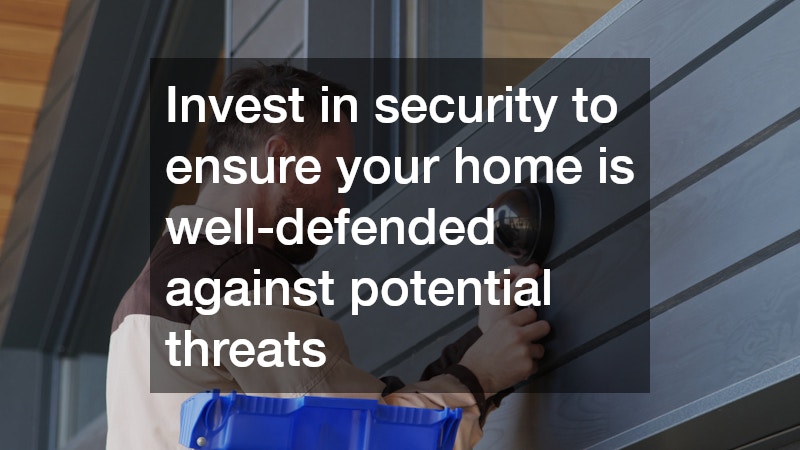In today’s world, ensuring your home is secure is more crucial than ever. With numerous home security solutions available in the market, selecting the right one can be overwhelming. This guide will help you make an informed decision by exploring different aspects of security systems.
From traditional alarm systems to advanced smart home technology, understanding your options is key to protecting your loved ones and your property. Factors such as ease of use, reliability, and integration with other devices should be considered when choosing a system. Additionally, assessing your specific needs and potential vulnerabilities can help you tailor a security plan that provides peace of mind. Investing in the right house security measures today can prevent future risks and ensure your home remains a safe haven.
Understanding Your Security Needs
Before diving into specific home security solutions, it’s important to assess your unique needs. Every home is different, and factors like location, size, and potential vulnerabilities should shape your security strategy. Understanding these elements will guide you toward a more tailored and effective security system.
Consider potential risks you face based on crime rates in your neighborhood. Analyzing local crime statistics and trends can reveal the types of crimes prevalent in your area, helping you prioritize certain features. For instance, homes in high burglary-prone areas might benefit more from advanced alarm systems and surveillance cameras.
Additionally, think about your family’s lifestyle and the specific protection you require. If you often travel, a system with remote monitoring capabilities is advantageous. Conversely, large families or those with pets may need systems that can accommodate frequent movement without triggering false alarms.
Exploring System Types
There are several types of home security systems, each offering unique benefits. The primary categories include monitored, unmonitored, wired, and wireless systems. Familiarizing yourself with these options will help you identify which system best aligns with your specific security needs.
Monitored systems offer 24/7 surveillance and alerts to a security company, ensuring rapid response during emergencies. Unmonitored systems, on the other hand, rely on loud sirens to alert you and your neighbors of intrusions, offering a cost-effective solution without monthly fees. Depending on your budget and preference for professional oversight, you can choose either type.
Another consideration is the installation method—wired versus wireless. Wired systems are typically more reliable but can be expensive and difficult to install. Meanwhile, wireless systems offer flexibility and easy installation, making them ideal for renters or those who plan to move in the near future.
Evaluating Essential Features
When evaluating home security options, focus on essential features that can enhance your home’s safety. Key features to consider include motion detectors, surveillance cameras, and smart home integration. Each component plays a vital role in establishing a comprehensive security network.
Motion detectors are crucial for detecting unauthorized movement within and around your home. They can trigger alerts or alarms when unusual activity is detected, providing a timely warning of possible intrusions. To maximize coverage, consider systems that offer a range of detector types, including infrared and ultrasonic sensors.
Surveillance cameras are another critical component, offering real-time monitoring and recorded evidence of incidents. Whether for indoor or outdoor use, prioritize high-resolution cameras with night vision capabilities. Additionally, smart home integration allows you to control and monitor your security system through apps, providing convenience and immediate alerts wherever you are.
Comparing Costs and Subscription Plans
Understanding the cost implications of home security solutions is integral to making an informed decision. Security systems can involve upfront purchase costs, installation fees, and subscription plans for monitoring services. It’s essential to compare these costs across different systems to find an affordable yet effective solution.
While initial equipment prices can vary widely, many providers offer financing options or discounts for bundled packages. Always consider the long-term financial commitment of subscription plans, which can range from monthly to annually. Opt for plans that offer flexibility and features that cater to your specific needs, such as mobile app access or additional cameras.
Additionally, keep an eye out for hidden fees such as maintenance charges or early termination penalties in contracts. Reading the fine print ensures you’re aware of all potential costs involved. Choosing the right security solution goes beyond just initial and monthly expenses—it’s about understanding the total cost of ownership over time.
After evaluating your needs, available options, essential features, and costs, the final decision comes down to which system best aligns with your lifestyle and budget. Take advantage of trial periods that many companies offer, allowing you to test systems before committing. This helps ensure the security solution you choose adequately meets your expectations.
It’s also beneficial to read reviews and ratings from other customers who have similar home layouts or security concerns. Community feedback can provide valuable insight into a system’s reliability and customer service quality. Additionally, professional installation reviews can reveal potential installation challenges and tips for optimal setup.
Ultimately, choosing the right home security solution involves balancing coverage, convenience, and cost to best protect your home and loved ones. This informed approach not only enhances security but also offers peace of mind, knowing your home is well-defended against potential threats.

